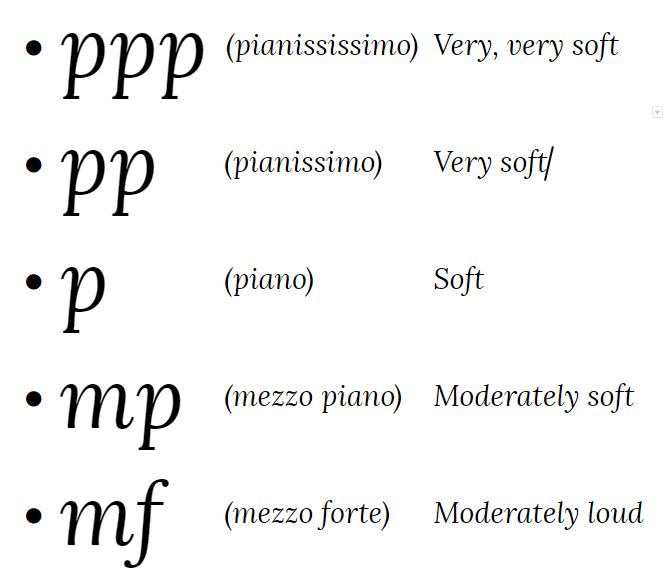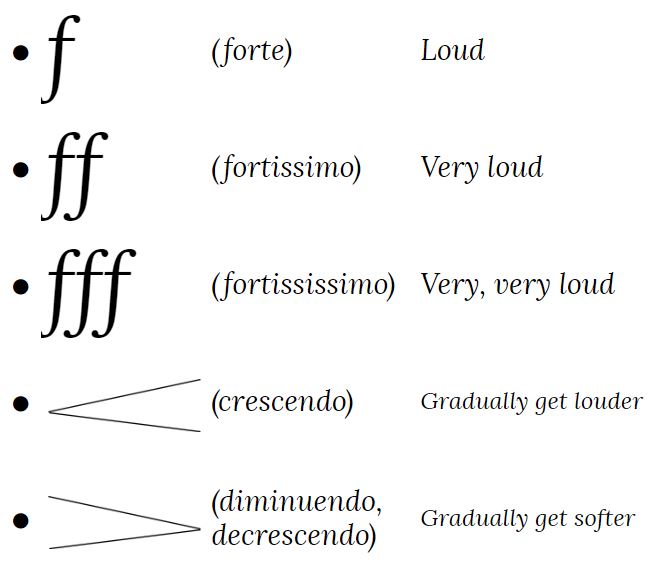Dynamics, or how loud or soft music is played, can really turn a nice piece of music into a masterpiece. As such, you will definitely want to pay attention to all those dynamic markings you may find in your music!
List of Dynamics:



Dynamic Terms are Written in Italian
Music has been around since the beginning of time. But it wasn’t until around 1000 A.D. that music started to be written. At that point, writers of music had to create their own way of documenting how music was written. Since the first ones that started to attempt writing music were Italian, the terms are still used today.
So now when you look at music, you will discover a lot of Italian terms and writing. Essentially, you are learning another language when you are reading music! It may not make a lot of sense to you now, but the more you are exposed to these terms, the easier it will become to remember them.
How to Play Dynamics
When you are first beginning to play an instrument, a lot of emphasis is put on learning the notes. You usually begin learning what note on a piece of paper correlates with what note is on your instrument. As time goes one, you will learn not only what to play, but how. Dynamics become part of the how you play an instrument.
It really is pretty intuitive if you think about it. Intonation and inflection in our voice (our own personal instruments) are begun when you are first born. In fact, interestingly enough, babies first learn how to speak before they learn the what. For example, a baby will begin to fuss quietly, then become louder and louder as the need gets more prominent. Their needs are conveyed quite well by how they say whatever they say (usually incomprehensible noises). They don’t even know what to say, but knowing how to say it is quite enough for the message to be heard!

Dynamics play a huge part in our understanding of language.
The saying, I hear you loud and clear is another example of the importance of dynamics, even in our every day language. Imagine if we just spoke in monotone. So much of our understanding of what people are saying would be lost without the dynamics and intonations given when we speak. The same is true of music!
Just like a person conveys a great deal of a language with its dynamics and intonations, so does playing dynamics in music. Just how loudly and softly you play the music conveys a great deal of the message of the music.
Let’s take a closer look at the different messages dynamics can convey:
Piano (soft), pianissimo (very soft), or pianississimo (very, very soft):
- When you are playing softly, the music could be mysterious.
- It could be peaceful.
- It could be suspenseful.
- It could paint a picture of solemnity.
- It could be sorrowful, or mournful.
- It could convey a completion, or an end.
Forte (loud), fortissimo (very loud), or fortississimo (very, very loud):
- When playing loudly, the music could convey happiness.
- It could mean a celebration.
- It could be angry.
- It could be climatic.
- It could also convey a completion, or a final end.
- It could convey mayhem, or chaos.
Crescendo (gradually getting louder):
- Crescendo could be used to build suspense.
- It could be used to build to a climax.
- It could show anticipation, or excitement.
- It could be used for movement.
- It is common to use a crescendo with a scale that ascends.
Decrescendo, or diminuendo (gradually getting softer):
- Decrescendo could be used to calm.
- It could be used to return to suspense.
- It can give the listeners a bit of relief.
Sforzando, or accent (a sudden emphasis on a note):
- An accent draws the listeners attention.
- It can be used as a surprise.
- It can be used to draw emphasis on a certain note, or series of notes.
- Accents can often draw out a melody in a complicated arrangement of notes.
- It can convey a sense of urgency.
Playing with dynamics takes practice, but you can see just how much of a difference it can take in your music.
Paint a picture. It helps to seek to paint a picture in your mind when you are playing music. As you are painting a scene, or a picture, it can help you in knowing how to play the music, what dynamics to add, to create the image you desire.
Describe a story. Music often is a story. Think of the example of dynamics in The Nutcracker. That’s exactly what it is! The Nutcracker is a story that is told strictly through music and dance. There is no language, no speaking to tell you what is going on. But millions of people watch The Nutcracker year after year, time after time, to hear the music of the story conveyed through dance and music. The music conveys a story that is now one of the most well-known stories and well-known music of all time. The dynamics in the music play such a huge part in that role as you create a story through the music.
Think of how much the music builds when the Mouse King is in battle with the Nutcracker. And the accents that are portrayed through the stabbing and the dying of the Mouse King. Then the music is swept away in the dreams of Claire. As she dances through snowflakes and sugar plum fairies in the mystical world, the dynamics convey the message of the song.
Literally How to Play Dynamics on an Instrument
If you are wondering just how to apply this knowledge into your instrument, and if you are wondering exactly how to do that, it is pretty simple. You can affect how loud or how soft you play by just how hard you press a key on a piano, or how hard you blow into a trumpet, or how hard you push down on your violin.
Each instrument can be played with dynamics (except perhaps, a few of them such as the organ). Just as your voice can become louder or softer by how hard you yell, or how quietly you whisper, each instrument does the same.
Tel loves her life as a piano player, a piano teacher, and a mom. Amid piano blogging, piano teaching, and piano playing, she loves a chance to fit in a good exercise class, volunteer at her kids’ school and at her church, and go on long dates with her husband. Full bio at About Tel.



Thanks